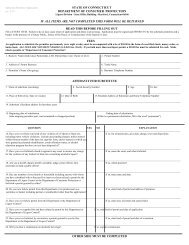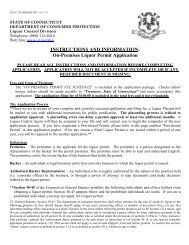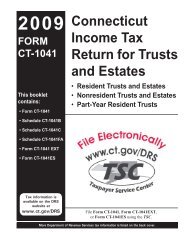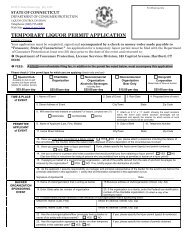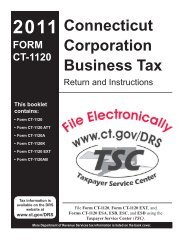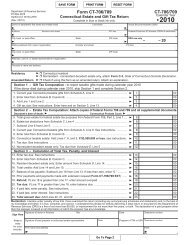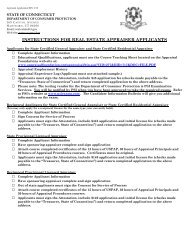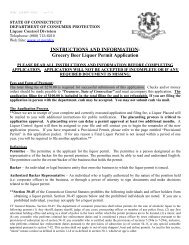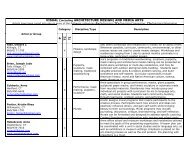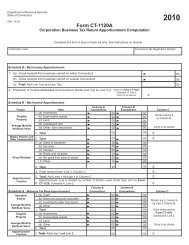Vendor Profile and W-9 Forms - Connecticut Commission on Culture ...
Vendor Profile and W-9 Forms - Connecticut Commission on Culture ...
Vendor Profile and W-9 Forms - Connecticut Commission on Culture ...
You also want an ePaper? Increase the reach of your titles
YUMPU automatically turns print PDFs into web optimized ePapers that Google loves.
Form W-9 (Rev. 10-2007) Page 2● The U.S. grantor or other owner of a grantor trust <str<strong>on</strong>g>and</str<strong>on</strong>g> not thetrust, <str<strong>on</strong>g>and</str<strong>on</strong>g>● The U.S. trust (other than a grantor trust) <str<strong>on</strong>g>and</str<strong>on</strong>g> not thebeneficiaries of the trust.Foreign pers<strong>on</strong>. If you are a foreign pers<strong>on</strong>, do not use FormW-9. Instead, use the appropriate Form W-8 (see Publicati<strong>on</strong>515, Withholding of Tax <strong>on</strong> N<strong>on</strong>resident Aliens <str<strong>on</strong>g>and</str<strong>on</strong>g> ForeignEntities).N<strong>on</strong>resident alien who becomes a resident alien. Generally,<strong>on</strong>ly a n<strong>on</strong>resident alien individual may use the terms of a taxtreaty to reduce or eliminate U.S. tax <strong>on</strong> certain types of income.However, most tax treaties c<strong>on</strong>tain a provisi<strong>on</strong> known as a“saving clause.” Excepti<strong>on</strong>s specified in the saving clause maypermit an exempti<strong>on</strong> from tax to c<strong>on</strong>tinue for certain types ofincome even after the payee has otherwise become a U.S.resident alien for tax purposes.If you are a U.S. resident alien who is relying <strong>on</strong> an excepti<strong>on</strong>c<strong>on</strong>tained in the saving clause of a tax treaty to claim anexempti<strong>on</strong> from U.S. tax <strong>on</strong> certain types of income, you mustattach a statement to Form W-9 that specifies the following fiveitems:1. The treaty country. Generally, this must be the same treatyunder which you claimed exempti<strong>on</strong> from tax as a n<strong>on</strong>residentalien.2. The treaty article addressing the income.3. The article number (or locati<strong>on</strong>) in the tax treaty thatc<strong>on</strong>tains the saving clause <str<strong>on</strong>g>and</str<strong>on</strong>g> its excepti<strong>on</strong>s.4. The type <str<strong>on</strong>g>and</str<strong>on</strong>g> amount of income that qualifies for theexempti<strong>on</strong> from tax.5. Sufficient facts to justify the exempti<strong>on</strong> from tax under theterms of the treaty article.Example. Article 20 of the U.S.-China income tax treaty allowsan exempti<strong>on</strong> from tax for scholarship income received by aChinese student temporarily present in the United States. UnderU.S. law, this student will become a resident alien for taxpurposes if his or her stay in the United States exceeds 5calendar years. However, paragraph 2 of the first Protocol to theU.S.-China treaty (dated April 30, 1984) allows the provisi<strong>on</strong>s ofArticle 20 to c<strong>on</strong>tinue to apply even after the Chinese studentbecomes a resident alien of the United States. A Chinesestudent who qualifies for this excepti<strong>on</strong> (under paragraph 2 ofthe first protocol) <str<strong>on</strong>g>and</str<strong>on</strong>g> is relying <strong>on</strong> this excepti<strong>on</strong> to claim anexempti<strong>on</strong> from tax <strong>on</strong> his or her scholarship or fellowshipincome would attach to Form W-9 a statement that includes theinformati<strong>on</strong> described above to support that exempti<strong>on</strong>.If you are a n<strong>on</strong>resident alien or a foreign entity not subject tobackup withholding, give the requester the appropriatecompleted Form W-8.What is backup withholding? Pers<strong>on</strong>s making certain paymentsto you must under certain c<strong>on</strong>diti<strong>on</strong>s withhold <str<strong>on</strong>g>and</str<strong>on</strong>g> pay to theIRS 28% of such payments. This is called “backup withholding.”Payments that may be subject to backup withholding includeinterest, tax-exempt interest, dividends, broker <str<strong>on</strong>g>and</str<strong>on</strong>g> barterexchange transacti<strong>on</strong>s, rents, royalties, n<strong>on</strong>employee pay, <str<strong>on</strong>g>and</str<strong>on</strong>g>certain payments from fishing boat operators. Real estatetransacti<strong>on</strong>s are not subject to backup withholding.You will not be subject to backup withholding <strong>on</strong> paymentsyou receive if you give the requester your correct TIN, make theproper certificati<strong>on</strong>s, <str<strong>on</strong>g>and</str<strong>on</strong>g> report all your taxable interest <str<strong>on</strong>g>and</str<strong>on</strong>g>dividends <strong>on</strong> your tax return.Payments you receive will be subject to backupwithholding if:1. You do not furnish your TIN to the requester,2. You do not certify your TIN when required (see the Part IIinstructi<strong>on</strong>s <strong>on</strong> page 3 for details),3. The IRS tells the requester that you furnished an incorrectTIN,4. The IRS tells you that you are subject to backupwithholding because you did not report all your interest <str<strong>on</strong>g>and</str<strong>on</strong>g>dividends <strong>on</strong> your tax return (for reportable interest <str<strong>on</strong>g>and</str<strong>on</strong>g>dividends <strong>on</strong>ly), or5. You do not certify to the requester that you are not subjectto backup withholding under 4 above (for reportable interest <str<strong>on</strong>g>and</str<strong>on</strong>g>dividend accounts opened after 1983 <strong>on</strong>ly).Certain payees <str<strong>on</strong>g>and</str<strong>on</strong>g> payments are exempt from backupwithholding. See the instructi<strong>on</strong>s below <str<strong>on</strong>g>and</str<strong>on</strong>g> the separateInstructi<strong>on</strong>s for the Requester of Form W-9.Also see Special rules for partnerships <strong>on</strong> page 1.PenaltiesFailure to furnish TIN. If you fail to furnish your correct TIN to arequester, you are subject to a penalty of $50 for each suchfailure unless your failure is due to reas<strong>on</strong>able cause <str<strong>on</strong>g>and</str<strong>on</strong>g> not towillful neglect.Civil penalty for false informati<strong>on</strong> with respect towithholding. If you make a false statement with no reas<strong>on</strong>ablebasis that results in no backup withholding, you are subject to a$500 penalty.Criminal penalty for falsifying informati<strong>on</strong>. Willfully falsifyingcertificati<strong>on</strong>s or affirmati<strong>on</strong>s may subject you to criminalpenalties including fines <str<strong>on</strong>g>and</str<strong>on</strong>g>/or impris<strong>on</strong>ment.Misuse of TINs. If the requester discloses or uses TINs inviolati<strong>on</strong> of federal law, the requester may be subject to civil <str<strong>on</strong>g>and</str<strong>on</strong>g>criminal penalties.Specific Instructi<strong>on</strong>sNameIf you are an individual, you must generally enter the nameshown <strong>on</strong> your income tax return. However, if you have changedyour last name, for instance, due to marriage without informingthe Social Security Administrati<strong>on</strong> of the name change, enteryour first name, the last name shown <strong>on</strong> your social securitycard, <str<strong>on</strong>g>and</str<strong>on</strong>g> your new last name.If the account is in joint names, list first, <str<strong>on</strong>g>and</str<strong>on</strong>g> then circle, thename of the pers<strong>on</strong> or entity whose number you entered in Part Iof the form.Sole proprietor. Enter your individual name as shown <strong>on</strong> yourincome tax return <strong>on</strong> the “Name” line. You may enter yourbusiness, trade, or “doing business as (DBA)” name <strong>on</strong> the“Business name” line.Limited liability company (LLC). Check the “Limited liabilitycompany” box <strong>on</strong>ly <str<strong>on</strong>g>and</str<strong>on</strong>g> enter the appropriate code for the taxclassificati<strong>on</strong> (“D” for disregarded entity, “C” for corporati<strong>on</strong>, “P”for partnership) in the space provided.For a single-member LLC (including a foreign LLC with adomestic owner) that is disregarded as an entity separate fromits owner under Regulati<strong>on</strong>s secti<strong>on</strong> 301.7701-3, enter theowner’s name <strong>on</strong> the “Name” line. Enter the LLC’s name <strong>on</strong> the“Business name” line.For an LLC classified as a partnership or a corporati<strong>on</strong>, enterthe LLC’s name <strong>on</strong> the “Name” line <str<strong>on</strong>g>and</str<strong>on</strong>g> any business, trade, orDBA name <strong>on</strong> the “Business name” line.Other entities. Enter your business name as shown <strong>on</strong> requiredfederal tax documents <strong>on</strong> the “Name” line. This name shouldmatch the name shown <strong>on</strong> the charter or other legal documentcreating the entity. You may enter any business, trade, or DBAname <strong>on</strong> the “Business name” line.Note. You are requested to check the appropriate box for yourstatus (individual/sole proprietor, corporati<strong>on</strong>, etc.).Exempt PayeeIf you are exempt from backup withholding, enter your name asdescribed above <str<strong>on</strong>g>and</str<strong>on</strong>g> check the appropriate box for your status,then check the “Exempt payee” box in the line following thebusiness name, sign <str<strong>on</strong>g>and</str<strong>on</strong>g> date the form.



